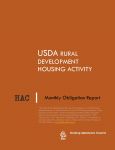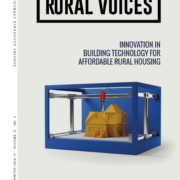HAC News: March 2, 2017
HAC News Formats. pdf
February 2, 2017
Vol. 46, No. 5
Trump FY18 budget outline expected March 16 • Senate approves Ben Carson as HUD Secretary • Task forces forming to consider reducing regulations • CDFI funds offered, including for CDFIs serving Native American communities • Comments sought on standards for federal data on race and ethnicity • Research shows severity of affordable housing shortage for lowest-income renters • New data on U.S. farmworkers published • HUD offers Manufactured Home Dispute Resolution Program • Duty to Serve overview video posted • Webinar, March 6: “How President Trump’s First Budget Could Impact Affordable Housing”
HAC News Formats. pdf
March 2, 2017
Vol. 46, No. 5
Trump FY18 budget outline expected March 16. The Administration wants to keep the 2011 Budget Control Act spending caps, but change the requirement that cuts in defense and non-defense funding must be proportional. It will request a $54 billion (10%) increase in defense spending. To stay under the cap, the same amount would have to be cut from non-defense funding; that calculation does not take account of tax cuts, deficit reduction, and mandatory spending on programs like Social Security. A more detailed budget proposal will be released in May.
Senate approves Ben Carson as HUD Secretary. The Senate confirmed Carson on March 2 by a 58-41 vote. The Senate Agriculture Committee has not yet scheduled a hearing on Sonny Perdue’s nomination to be USDA Secretary.
Task forces forming to consider reducing regulations. In a February 24 Executive Order, President Trump expanded on his January 30 Executive Order requiring elimination of two existing regulations for each new one (see HAC News, 2/2/17). The head of each agency is required to designate a Regulatory Reform Officer and create a Regulatory Reform Task Force to evaluate existing regulations and recommend repeal, replacement, or change. Each task force must seek input from stakeholders. Each task force must report to its agency head within 90 days.
CDFI funds offered, including for CDFIs serving Native American communities. The CDFI Program makes Financial Assistance awards (in the form of loans, grants, equity investments, deposits, or credit union shares) to Certified CDFIs and Technical Assistance grants to Certified, Certifiable, and Emerging CDFIs to build their organizational capacity. The Native American CDFI Program offers the same to CDFIs serving Native communities. For each program, the application process has two steps with deadlines of March 24 and April 28. For more information, contact the CDFI Fund Help Desk, 202-653-0421.
Comments sought on standards for federal data on race and ethnicity. OMB requests comments by May 1 on a report drafted by a federal interagency working group suggesting revisions to OMB’s Standards for Maintaining, Collecting, and Presenting Federal Data on Race and Ethnicity. The standards are used in the decennial census, other surveys, forms such as mortgage applications, and more. This notice lists specific questions, including whether to add a “Middle Eastern or North African” classification and what sub-categories to use for American Indian or Alaska Native, Black or African American, Hispanic or Latino, and other major classifications. For more information, contact Jennifer Park, OMB.
Research shows severity of affordable housing shortage for lowest-income renters. The GAP: A Shortage of Affordable Homes, released March 2 by the National Low Income Housing Coalition, reports there are only 35 affordable and available units for every 100 extremely low-income renter households nationwide, and 71% of ELI renters are severely cost-burdened, spending more than half their income on rent and utilities. ELI renters are those with incomes below 30% of area median or below the poverty level, whichever is higher. The report includes recommendations for better targeting of federal housing expenditures, including reform of the mortgage interest deduction and Low Income Housing Tax Credit.
New data on U.S. farmworkers published. Findings from the National Agricultural Workers Survey (NAWS) 2013-2014: A Demographic and Employment Profile of United States Farmworkers, recently released by the Department of Labor, covers housing as well as other topics. Thirteen percent of all farmworkers surveyed lived free in employer-provided housing. Among all those who paid for housing, 74% paid less than $600 per month, but the report does not compare rent to income. Those without work authorization were less likely than authorized workers to live in single-family homes, and more likely to live in mobile homes (23% and 15% respectively) or apartments (23% and 11%). Migrant workers lived in crowded dwellings more often than settled workers (40% compared to 29%), and unauthorized workers were twice as likely as authorized workers to be overcrowded (41% and 21%). Nationwide, only 3.3% of homes are overcrowded.
HUD offers Manufactured Home Dispute Resolution Program. The program resolves disputes between manufacturers, retailers, and installers when the parties cannot agree on a solution to a construction and/or safety defect within the first year of the first installation of a manufactured home. HUD’s DRP functions in 24 states; the other 26 have state programs. For more information visit https://www.huddrp.net, email info@huddrp.net, or call 571-882-2928.
Duty to Serve overview video posted. The three-minute video covers the basics of Fannie Mae’s and Freddie Mac’s Duty to Serve program. Data and other tools from the Federal Housing Finance Agency are also available online.
Webinar, March 6: “How President Trump’s First Budget Could Impact Affordable Housing” The Campaign for Housing and Community Development Funding will hold a webinar on Monday, March 6 at 3-4:00 Eastern time, about the significant threats facing affordable housing and community development programs, including USDA rural housing, and how you can help protect them. At the webinar, CHCDF will also launch a new report and new information tools, including factsheets, sample op-eds, and statewide data on the economic impact of HUD and USDA rural housing investments


